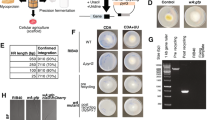Abstract
STRONG suggestive evidence1 exists to support earlier proposals2 that Nocardia rhodnii, the extracellular symbiont of Rhodnius, contributes essential food factors to its host. In recent years, however, the evidence has been conflicting, particularly where it concerns the nature of these factors. In 1954, Geigy, Halff and Kocher3 isolated a micro-organism from Triatoma infestans similar to N. rhodnii and found that whereas it synthesized thiamine and other vitamins in minimal amounts, there was a 2,500-fold hyper-production of folic acid. Bewig and Schwartz4, however, later claimed that this organism was not N. rhodnii, and was not symbiotic. They showed that pure cultures of N. rhodnii on an elaborate semi-synthetic medium synthesized minimal amounts of folic acid, no vitamin B12 and no folininic acid. They found too that injection of vitamins into sterile Rhodnius failed to induce moulting. In 1956 Baines5, using feeding and injection techniques, came to the conclusion that Rhodnius is dependent on N. rhodnii for pyridoxine, calcium pantothenate, nicotinamide and thiamine, but that biotin and folic acid are present in adequate concentration in the host blood to meet the requirements of Rhodnius.
This is a preview of subscription content, access via your institution
Access options
Subscribe to this journal
Receive 51 print issues and online access
$199.00 per year
only $3.90 per issue
Buy this article
- Purchase on Springer Link
- Instant access to full article PDF
Prices may be subject to local taxes which are calculated during checkout
Similar content being viewed by others
References
See Wigglesworth, V. B., Tijdsch. Entomol., 95, 63 (1952).
See Wigglesworth, V. B., Parasit., 21, 288 (1929). Aschner, M., Z. Morph. Oekol. Tiere, 20, 368 (1931).
Geigy, R., Halff, L. A., and Kocher, V., Acta Trop., Basel, 11, 163 (1954).
Bewig, F., and Schwartz, W., Naturwiss., 41, 435 (1954). Naturwiss., 42, 423 (1955); Ark. Mikrobiol., 24, 174 (1956).
Baines, S., J. Exp. Biol., 33, 533 (1956).
Harington, J. S., Parasit., 50, 273 (1960).
Vitamin estimations performed by South African Bureau of Standards, Pretoria; thiamine by a titrimetric method using Lactobacillus fermenti (“Vitamin Methods”, 1, 372, 1950, by P. György); folic acid by a titrimetric method using Streptococcus faecalis (“vitamin Assay”, second ed., 231, 1951).
Bewig, F., and Schwartz, W., Ark. Mikrobiol., 24, 174 (1956).
Author information
Authors and Affiliations
Rights and permissions
About this article
Cite this article
HARINGTON, J. Synthesis of Thiamine and Folic Acid by Nocardia rhodnii, the Micro-symbiont of Rhodnius prolixus . Nature 188, 1027–1028 (1960). https://doi.org/10.1038/1881027a0
Issue Date:
DOI: https://doi.org/10.1038/1881027a0
This article is cited by
-
Effects of Wolbachia elimination and B-vitamin supplementation on bed bug development and reproduction
Scientific Reports (2022)
-
Ontogeny, species identity, and environment dominate microbiome dynamics in wild populations of kissing bugs (Triatominae)
Microbiome (2020)
-
The gastric caeca of pentatomids as a house for actinomycetes
BMC Microbiology (2012)
Comments
By submitting a comment you agree to abide by our Terms and Community Guidelines. If you find something abusive or that does not comply with our terms or guidelines please flag it as inappropriate.



